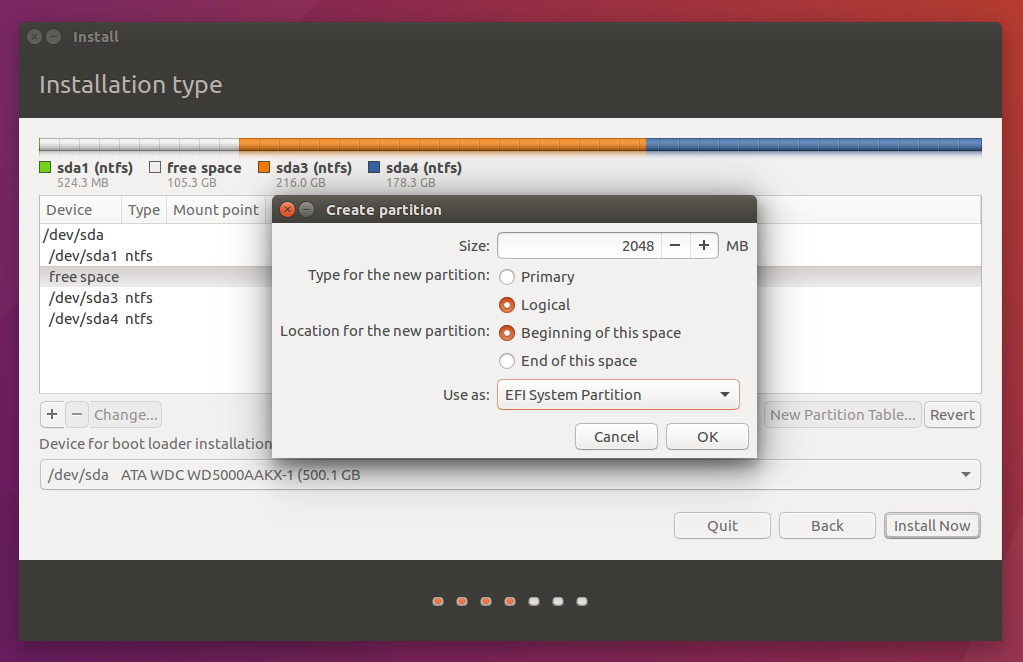Grub-efi-amd64-signed Package Failed To Install


What I'm seeing is that the install gets to the point where it tries to install grub2, and then fails because it can't install to '/target/'. And that crashes the installer completely, which shouldn't happen. Why is it trying to install to /target/ instead of /boot - do you know? Is there a non-interactive boot loader I can stick in? I don't need grub - freebsd has a nice, albeit primitive, boot manager that will work fine if I can just get a vanilla loader that will boot ubuntu.
I can probably even use syscmdr 7, if I can just get a loader for ubuntu. I haven't tried your suggestion yet, but since the installer crashed again with the same error, I'll take a look for /efi/ubuntu now.
Debian Bug report logs - #809788 Failed to install Xenial in UEFI mode, failed with 'grub-efi-amd64-signed package failed to install into /target/'.
It's interesting that it apparently thinks the problem, or some problem, is in the ubiquity installer, which it seems to say is not an ubuntu package and should be removed. Last edited by scratch65535; December 11th, 2013 at 01:08 PM. Can you mount (while running live media) the EFI partition and take a look at /EFI/ubuntu? Sometimes this directory gets corrupted and the grub install will fail until it is fixed (bug #1090829).There is no such file/directory, if I understand what you're asking. There's /cdrom/efi/boot/bootx64.efi and /cdrom/efi/boot/grubx64.efi, and there's /cdrom/ubuntu that appears to be a link to /cdrom (I might be wrong - I don't know the graphic syntax, but it looks as though it just points back up to /cdrom). Xubuntu@xubuntu:~$ sudo parted -l Model: ATA WDC WD1003FBYX-0 (scsi) Disk /dev/sda: 1000GB Sector size (logical/physical): 512B/512B Partition Table: msdos Number Start End Size Type File system Flags 1 1049kB 256MB 255MB primary ext4 3 256MB 4352MB 4096MB primary linux-swap(v1) 4 4352MB 64.4GB 60.1GB primary ext4 2 64.4GB 1000GB 936GB primary ntfs Warning: Unable to open /dev/sr0 read-write (Read-only file system).
/dev/sr0 has been opened read-only. Error: Can't have a partition outside the disk! The Original Reiki Handbook Of Dr. Textbook Of Preventive And Community Dentistry Pdf. Mikao Usui Pdf S there. Code: Number Start End Size Type File system Flags 1 1049kB 256MB 255MB primary ext4??
3 256MB 4352MB 4096MB primary linux-swap(v1) 4 4352MB 64.4GB 60.1GB primary ext4 2 64.4GB 1000GB 936GB primary ntfsIf the first partition is your /boot partition then it needs to have a ' boot' flag. You can use gparted to put a boot flag there, [Rt. Click on the partition in gparted, 'manage flags', select 'boot'].
You have 'msdos' partition table, which means you are not booting in EFI. Because Windows and Ubuntu CANNOT boot in EFI from 'msdos' disk. There doesn't appear to be a boot mode setting in the bios that I can find, on-screen or in the printed docs. The only boot choices I have are things like splash, int19, etc.
After setting the boot bit, I tried installing the boot by hand using grub-install. I installed it to the main partition since I can't seem to find a requirement saying it's to have its own partition. I reckoned it would clear the bit in the boot partition and set it in the main one. Diy Electrical Installation Scotland.
When I rebooted, it booted as far as grub, but didn't get any further even when I told it 'boot'. When I loaded from the dvd and looked at the part table, the boot bit was still where I left it and there was no bit in the main part. So what I reckon I'll try now, unless you have some other idea, is to grub-install to that boot partition and see whether that helps. (If I understand what you mean, it's greenish rather than black or purplish) Last edited by scratch65535; December 11th, 2013 at 05:11 PM.
I have googled, and any solutions I found, such as setting up my own partitions by hand, have failed with the same error message. For example, this was recommended in a similar thread. - It did not work for me. - Linux Mint 18.1 Cinnamon x64 'Serena'.
- Desktop system has 3 drives. One SSD (boot drive), two HDD, data and backups. - I want to leave the HDDs untouched by the install process. - Trying to install Mint as the only OS on my SSD. Windows will be virtualized later.